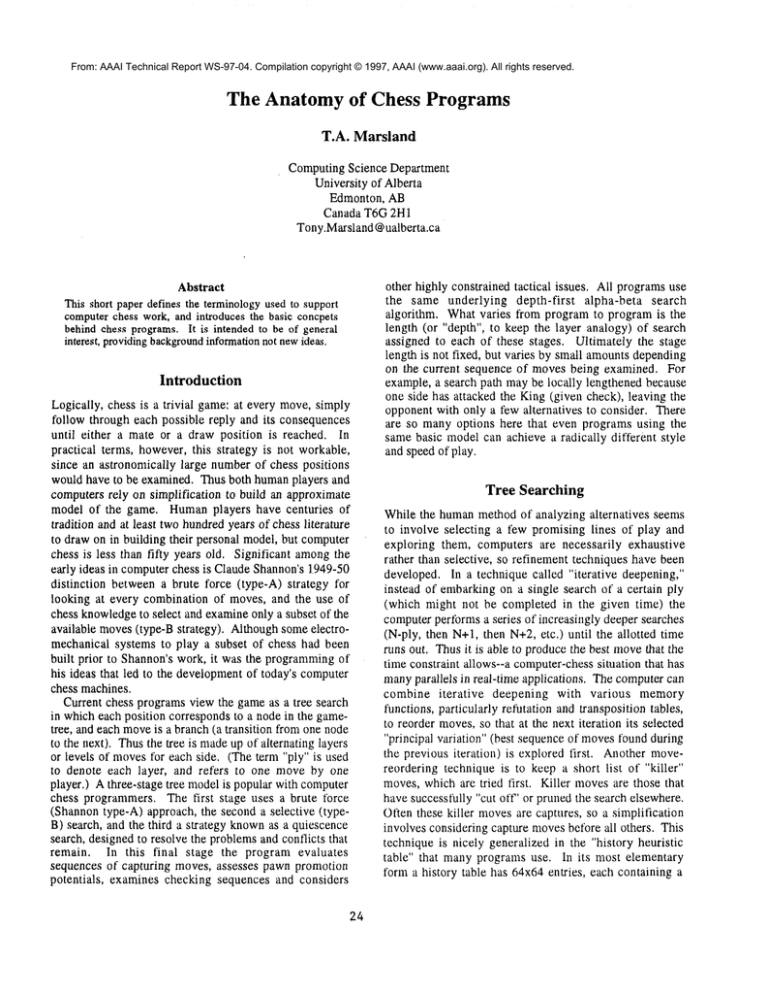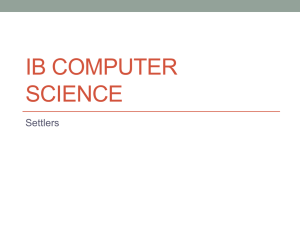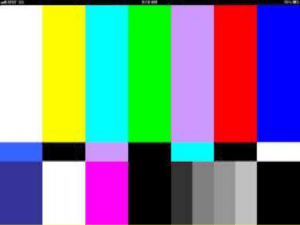
From: AAAI Technical Report WS-97-04. Compilation copyright © 1997, AAAI (www.aaai.org). All rights reserved.
The Anatomy of Chess Programs
T.A.
Marsland
ComputingScience Department
University of Alberta
Edmonton, AB
Canada T6G 2H1
Tony.Marsland@ualberta.ca
Abstract
This short paperdefines the terminologyusedto support
computer
chess work,andintroducesthe basic concpets
behindchess programs.It is intendedto be of general
interest, providing
background
information
not newideas.
Introduction
Logically, chess is a trivial game: at every move,simply
follow through each possible reply and its consequences
until either a mate or a draw position is reached. In
practical terms, however, this strategy is not workable,
since an astronomically large numberof chess positions
would have to be examined. Thus both humanplayers and
computersrely on simplification to build an approximate
model of the game. Humanplayers have centuries of
tradition and at least two hundredyears of chess literature
to draw on in building their personal model, but computer
chess is less than fifty years old. Significant amongthe
early ideas in computerchess is Claude Shannon’s1.949-50
distinction between a brute force (type-A) strategy for
looking at every combination of moves, and the use of
chess knowledgeto select and examineonly a subset of the
available moves(type-B strategy). Althoughsomeelectromechanical systems to play a subset of chess had been
built prior to Shannon’swork, it was the programmingof
his ideas that led to the developmentof today’s computer
chess machines.
Current chess programsview the gameas a tree search
in which each position corresponds to a node in the gametree, and each moveis a branch (a transition from one node
to the next). Thusthe tree is madeup of alternating layers
or levels of movesfor each side. (The term "ply" is used
to denote each layer, and refers to one move by one
player.) A three-stage tree modelis popular with computer
chess programmers. The first stage uses a brute force
(Shannontype-A) approach, the second a selective (typeB) search, and the third a strategy knownas a quiescence
search, designed to resolve the problemsand conflicts that
remain. In this final stage the program evaluates
sequences of capturing moves, assesses pawn promotion
potentials, examines checking sequences and considers
24
other highly constrained tactical issues. All programsuse
the same underlying depth-first
alpha-beta search
algorithm. What varies from program to program is the
length (or "depth", to keep the layer analogy) of search
assigned to each of these stages. Ultimately the stage
length is not fixed, but varies by small amountsdepending
on the current sequence of moves being examined. For
example, a search path maybe locally lengthened because
one side has attacked the King (given check), leaving the
opponent with only a few alternatives to consider. There
are so manyoptions here that even programs using the
same basic model can achieve a radically different style
and speed of play.
Tree Searching
While the humanmethod of analyzing alternatives seems
to involve selecting a few promising lines of play and
exploring them, computers are necessarily exhaustive
rather than selective, so refinement techniques have been
developed. In a technique called "iterative deepening,"
instead of embarkingon a single search of a certain ply
(which might not be completed in the given time) the
computerpertbrms a series of increasingly deeper searches
(N-ply, then N+I, then N+2, etc.) until the allotted time
runs out. Thusit is able to producethe best movethat the
time constraint allows--a computer-chesssituation that has
manyparallels in real-time applications. The computercan
combine iterative
deepening with various memory
functions, particularly refutation and transposition tables,
to reorder moves,so that at the next iteration its selected
"principal variation" (best sequence of movesfound during
the previous iteration) is explored first. Another movereordering technique is to keep a short list of "killer"
moves, which are tried first. Killer movesare those that
have successfully "cut oft’’ or prunedthe search elsewhere.
Often these killer movesare captures, so a simplification
involves considering capture movesbefore all others. This
technique is nicely generalized in the "history heuristic
table" that many programs use. In its most elementary
form a history table has 64x64entries, each containing a
Value
game positions each side might have close to 80 moves.
With today’s technology, programs exhaustively search 7
to 10 ply in the middle game, while at least one
programmerclaims to extend searches selectively to 40
ply! Selective extensions are based on heuristics devised
by individual programmers to explore the sphere of
influence associated with a key move: to examine the
movesthat might defend against a mate threat, or that
might provide a counter attack and thus indirectly avoid
some imminent loss. Selective extensions are not to be
confusedwith singular extensions. The latter technique reexaminesany movethat looks singularly good relative to
the others. The search depth is increased to determine
whether the singular move remains best. In some sense
this is a way of extending the principal variation in the
small. It is a potentially costly but interesting method.
More popular and more widely used is the null move
heuristic,
where one side provisionally
makes two
successive moves. If the value of the position remains
poor even with the benefit of two movesin a row, then the
line of play is abandoned. This is one way to identify
situations where an inevitable loss is otherwise being
pushed out of sight beyond the search horizon. While
manyforward pruning methodsfail too often to be useful,
null moveforward pruning is usually beneficial.
Brute Force
Full-width
Layers
Selective
Layers
Quiescent
Layers
Transposition
Value
value that measures the frequency with which the
corresponding possible move has recently pruned the
search.
Move-reordering mechanismsenhance the efficiency of
the depth-first alpha-beta search algorithm. Three other
improvements--Pearl’s Scout algorithm and the related
NegaScoutand Principal Variation Search (PVS) methods-share a commontheme: once a principal variation has
been found it is sufficient to showthat each alternative is
inferior. Anythat is not inferior mustbe re-searched, since
it nowconstitutes the preferred path. Another technique
for curtailing the search is called aspiration alpha-beta
search. In this approach the value of the tree from the
current position is estimated and a narrow search window
(customarily plus and minus the value of half a pawn
around that estimate) is used. Aspiration searching is
popular and better understood alternative to the Principal
Variation Search method,although not as efficient.
It is difficult to be precise about the advantages that
moresearching provides. The size of the chess tree for any
position is highly variable. In manyendgamesthere are
only about 8 movesfor each side, while in complexmiddle
25
Table
A transposition table serves as a cache memoryand is used
to store information about positions that have been visited
before, usually during an earlier part of an iterative
deepeningsearch. It is so called because it can be used to
recognize transpositions in the order of moves. Stored in
the entry associated with a position are important items
like the "value" of the position, the best movefrom there,
and the length of the previous search. "Value" is computed
by applying an evaluation function at the terminal nodes of
the tree (the nodes on the horizon where the search is
stopping). This evaluation function often includes
quiescent search to help resolve existing capture sequences
and other uncertainties in the position, such as pending
pawnpromotions. Transposition tables are also invaluable
as a means of extending search in the endgame,where only
a few new movesemerge at each node, the others leading
through transposition to positions that have been seen
before. These tables do not increase program size or
complexity, since the total space allocated to them is
simply a matter of cost. Each transposition-table entry
requires about 10 bytes of memory, and most programs
have tables in the range from 32,000 to 1 million entries,
though in 1993 one Supercomputer program boasted a
table with a 1,000 million entries! This wide range simply
reflects the memoryavailable to the programmer.
Program Performance
and Rating
The Future
Despite the underlying similarity in methodsthere is wide
variation in performance amongthe programs, even in
machines using identical hardware. In some cases this
merely reflects the effort put into the program’s
development. For example, although every program has
an opening book, there is no basic book for them to use.
Each team develops its own. At present these books vary
in size fl’om about 10,000 chess positions to about 500,000
positions, although one experimental program has 1.7
million book entries. Conversely, only a few people use
Ken Thompson’s CD-ROMdatabase of 5 and 6-piece
endgames.This is partly for technical reasons related to
relatively slow access to the database, but also because
most games finish before reaching these knownendings.
Perhaps programmersare just being realistic about howto
spend their time!
Whenit comes to speed of execution, contemporary
programs examine between 3,000 and 500,000 positions
per second on a single processor. Big differences in speed
exist even for programs using identical machines. There
are manyexplanations. Those who program in assembler
tend to have faster programs, but even for the same
programminglanguage, not all compilers (translators)
produce equally fast executable code. Muchdepends too
on the relative sizes of the brute force, the selective and the
quiescent search stages. Extra time is required in the
selective stage to assess and identify which moveswill be
examined. The extent of this slow, knowledge-based
process accounts for muchof the speed difference. One
other factor that influences the speed and strength of a
programis the size of its transposition table.
Althoughmanychess programsare similar to each other,
their relative playing strength can still differ greatly.
Determining that strength is no easy matter, since
programscan be tuned to performwell on any standard test
suite. For this reason the group whoproduce the Swedish
Rating List use a more traditional
approach. All
commercially available programs continually
and
automatically play games against each other, leading to
hundredsof statistically valid results. Fromthese data an
ELOrating is computed, muchlike the rating system used
tor chess-players in Americaand elsewhere. In the USthe
average player has a rating over 1500, while experts are in
the range 2000-2200 and masters are rated 2200-2400.
Above that come the super elite players called Grand
Masters, of whomabout 100 are active worldwide. At the
Eighth World Computer Chess Championships most
programs have an ELOrating in the range 2100-2500. The
current Swedishrating list is publishedin each issue of the
International ComputerChess Association Journal.
26
These days the top chess machines are challenging the
Grandmasters, especially in rapid play where the standalone PC-based machines have an advantage over
multiprocessor-based systems. Stand-alone machines are
especially fast, because they don’t need the services of a
computer network to transmit their moves. Multiprocessor
machinesusing 10 to 100 processors are often better at the
standard competition rate of play of 40 movesin 2 hours.
Soon systems with 1000 processors, each as powerful as a
high-performance PC, will be with us. Even if their
efficiency is only at the 50%level, they will be able to
search 2 or 3 ply deeper in a typical middle-gameposition
than any single-processor system. By then computers will
be clearly out-searching humans. Whether this will be
enough to compensate for the human’s proven strength in
long-term planning remains to be seen. Humanchess
players are especially skilled at simplifying complex
situations and identifying the fundamentalissues. They are
also adept at provoking iong-term weaknesses in their
opponent’sposition, until it becomesindefensible. Despite
these advantages, each year we drawcloser to realizing the
perennial prediction that computers will beat the best
humansat chess within 5 years. It could certainly take
anotherdecadeto achievethat, but the inevitability is clear.
References
These are general sources about Chess Programs and
ProgrammingTechniques.
Levy, D. ed. 1988. Computer Chess Compendium, New
York: Springer-Verlag.
Marsland, T.A. 1992. Computer Chess and Search. In
Encyclopediaof Artificial Intelligence, S. Shapiro (editor),
2nd edition, 224-241. NewYork: J. Wiley &Sons.
Herik, van den H.J. ed., since 1983. International
Computer Chess Association Journal, Universitiet
Maastricht, The Netherlands.
Marsland, T.A. and Schaeffer, J. eds. 1990 Computers,
Chess, and Cognition, NewYork: Springer-Verlag.
Various editors, 1997-1994. Advancesin ComputerChess,
Volumes1 to 7, wu:ious publishers.



